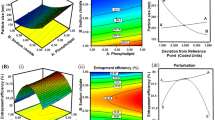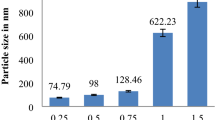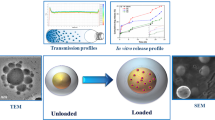Abstract
Creams and gels containing curcumin are popularized worldwide and marketed all over the world, but even after incorporation of high amount of curcumin in topical formulations, significant antioxidant and anti-aging effect could not be achieved. Objective of the present study was to develop vesicular system for delivery of curcumin to achieve enhanced topical bioavailability. Complex of curcumin with phosphatidyl choline (PC) was prepared and characterized on the basis of TLC, DSC, melting point and IR spectroscopic analysis. The complex was further converted into vesicles (phyto-vesicles). Liposomes and niosomes of curcumin were also prepared and all these vesicular formulations were incorporated into carbopol gel to make feasible for topical application on skin. Anti-aging effects of these formulations were compared with plain curcumin and physical mixture of curcumin with phosphatidyl choline in UV-induced oxidative stress in mice. Analytical reports along with spectroscopic data revealed the formation of the complex. In the present study, the phyto-vesicles were found to be most effective than all other formulations and plain curcumin in providing enhanced antioxidant and antiaging effect. This increase may be due to the amphiphilic nature of the complex, which greatly enhances the water and lipid miscibility of the curcumin. This study clearly indicates the superiority of CU–PC complex and the phyto-vesicles prepared from CU–PC complex over others in providing enhanced anti-aging, antioxidant and anti-wrinkle effect.


















Similar content being viewed by others
References
Aebi H (1974) Catalase. In: Bergmeyar (ed) Methods in enzymatic analysis. Academic Press, New York, pp 674–684
Aggarwal BB, Kumar A, Bharti AC (2003) Anticancer potential of curcumin: preclinical and clinical studies. Anticancer Res 23:363–398
Anand P, Kunnumakkara AB, Newman RA et al (2007) Bioavailability of curcumin: problems and promises. Mol Pharm 4:807–818
Ashawat MS, Saraf S, Saraf S (2007) Biochemical and histopathological studies of herbal cream against UV radiation induced damage. Trends Med Res 2:135–141
Bhattacharyya A (1997) Ageing. J Indian Med Assoc 95:601–602
Bombardelli E (1994) Phytosomes in functional cosmetics. Fitoterapia 65:320–327
Bombardelli E, Curri SB, Della LR (1989) Complexes between phospholipids and vegetal derivatives of biological interest. Fitoterapia 90(Suppl 1):1–9
Bombardelli E, Spelta M, Loggia DR, Sosa S, Tubaro A (1991) Aging skin: protective effect of silymarin–phytosome. Fitoterapia 62:115–122
Cui J, Yu B, Zhaoe Y et al (2009) Enhancement of oral absorption of curcumin by self-microemulsifying drug delivery systems. Int J Pharm 371:148–155
Ellman GL (1959) Tissue sulphydryl groups. Arch Biochem Biophys 82:70–77
Gornall AG, Bardwill CJ, David MM (1949) Determination of serum proteins by means of the biuret reaction. J Biol Chem 177:751–756
Gupta A, Ashawat MS, Saraf S, Saraf S (2007) Phytosome: a novel approach towards functional cosmetics. J Plant Sci 2:644–649
Gupta NK, Dixit VK (2010) Bioavailability enhancement of curcumin by complexation with phosphatidyl choline. J Pharm Sci. doi:10.1002/jps
Gupta NK, Nahata A, Dixit VK (2010) Development of a spectrofluorimetric method for the determination of curcumin. Asian J Tradit Med 5:51–57
Harman D (1983) Free radical theory of ageing: consequences of mitochondrial ageing. Age 6:86–94
Harman D (1999) Ageing: minimizing free radical damage. J Anti-Aging Med 2:15–36
Jung JW, Cha SH, Lee SC et al (1997) Age-related changes of water content in the rat skin. J Dermatol Sci 14:12–19
Kakkar P, Das B, Viswanathan PN (1984) A modified spectrophotometric assay of superoxide dismutase. Indian J Biochem Biophys 21:131–132
Kieffer FB, Wegrich P, Schwarzenbach R et al (2000) Percutaneous absorption of sunscreens in vitro: interspecies comparison, skin models and reproducibility aspects. Skin Pharmacol Appl Skin Physiol 13:324–335
Kligman AM, Zheng P, Lavker RM (1985) The anatomy and pathogenesis of wrinkles. Br J Dermatol 113:37–42
Lavker RM (1979) Structural alterations in exposed and unexposed aged skin. J Invest Dermatol 73:59–66
Leake CD (1968) Free radicals and ageing. Geriatrics 23:90–91
Marczylo TH, Verschoyle RD, Cooke DN et al (2007) Comparison of systemic availability of curcumin with that of curcumin formulated with phosphatidylcholine. Cancer Chemother Pharmacol 60:171–177
Meenakshi I, Jayaraman V, Ramakrishnan KM et al (2005) Ultrastructural differentiation of abnormal scars. Ann Burns Fire Disasters 1:2–11
Ogura R, Sugiyama M (1998) Cellular membrane damage and lipid peroxide following exposure of the skin to ultraviolet trace. In: Kligman AM, Takase Y (eds) Cutaneous ageing. University of Tokyo Press, Tokyo, pp 459–471
Ohkawa H, Onishi N, Yagi K (1979) Assay for lipid peroxidation in animal tissue by thiobarbituric acid reaction. Anal Biochem 95:351–358
Patel NA, Patel NJ, Patel RP (2009) Design and evaluation of transdermal drug delivery system for curcumin as an anti-inflammatory drug. Drug Dev Ind Pharm 35:234–242
Patel NA, Patel NJ, Patel RP (2009) Formulation and evaluation of curcumin gel for topical application. Pharm Dev Tech 14:80–89
Sharma A, Gupta NK, Dixit VK (2010) Complexation with phosphatidyl choline as a strategy for absorption enhancement of boswellic acid. Drug Deliv 17:587–595
Sharma RA, Gescher AJ, Steward WP (2005) Curcumin: the story so far. Eur J Cancer 41:1955–1968
Sharma S, Kaur IP (2006) Development and evaluation of sesamol as an antiaging agent. Int J Dermatol 45:200–208
Stadtman ER, Berlett BS (1997) Reactive oxygen-mediated protein oxidation in ageing and disease. Chem Res Toxicol 10:485–494
Tonnesen HH, Masson M, Loftsson T (2002) Studies of curcumin and curcuminoids. XXVII. Cyclodextrin complexation: solubility, chemical and photochemical stability. Int J Pharm 244:127–135
Woessner JF (1961) The determination of hydroxyproline in tissue and protein samples containing small proportions of this imino acid. Arch Biochem Biophys 93:440–447
Yanyu X, Yunmei S, Zhipeng C et al (2006) The preparation of silybin–phospholipid complex and the study on its pharmacokinetics in rats. Int J Pharm 307:77–82
Ying L, Yang DJ, Chen SL et al (2008) Comparative physiochemical characterization of phospholipids complex of puerarin formulated by conventional and supercritical methods. Pharm Res 25:563–577
Acknowledgments
The authors thank LIPOID GmbH (Germany) for providing the gift sample of phosphatidylcholine. The authors also acknowledge the Council of Scientific and Industrial Research (CSIR), New Delhi, India, for providing financial assistance in the form of Senior Research Fellowship (Grant no. 09/150/(0100)/2009/ EMR-I) to one of the author, Nishant Kumar Gupta.
Author information
Authors and Affiliations
Corresponding author
Rights and permissions
About this article
Cite this article
Gupta, N.K., Dixit, V.K. Development and evaluation of vesicular system for curcumin delivery. Arch Dermatol Res 303, 89–101 (2011). https://doi.org/10.1007/s00403-010-1096-6
Received:
Revised:
Accepted:
Published:
Issue Date:
DOI: https://doi.org/10.1007/s00403-010-1096-6




